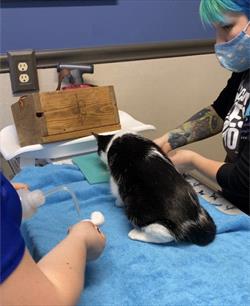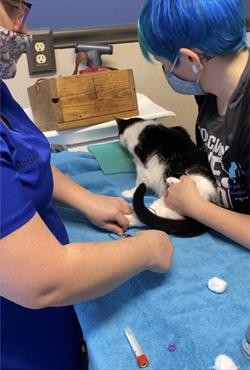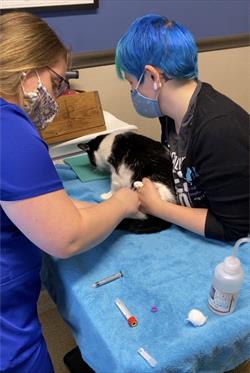Many cats are afraid at the veterinary hospital which can make it difficult, if not impossible, to examine the cat and provide the best care possible. Changes in temperature, heart rate, respiratory rate, blood pressure, and even blood glucose can occur, making it hard to determine if the cat is ill or in distress.
In addition to a physical exam, some cats require bloodwork to diagnose a disease or monitor their overall health. Drawing a cat’s blood can be a challenging process when they are afraid or uncomfortable. The good news is veterinary professionals can use these Low Stress Handling® techniques to minimize the cat’s distress during this procedure.
Step 1: Setting up the room
• The client can bring in the cat’s bed from home as well as their favorite treats.
• Before starting, make sure all needed items for the exam and blood draw are in the room to minimize entering and exiting. This will help to decrease wait times and give an opportunity for the cat to acclimate to the room.
• A non-slip mat should be placed on the table to provide warmth and traction when the procedure is performed.
• The cat’s favorite food can be offered prior, during, and after this procedure. You can also use petting or play if the cat enjoys this.
• Play classical music to help minimize stressful sounds throughout the hospital. If your hospital doesn’t offer this, you could play it from your phone or other device in the room with the cat.
Step 2: Prepping for the blood draw
• When choosing a location for a blood draw, consider where the cat is most comfortable, as well as avoiding any sensitive or painful areas.
• Prior to the blood draw, topical lidocaine can be applied to the location on the leg where the needle will be placed.
• Find the position in which the cat is most comfortable. For many, this may be the sternal position (see picture #1).
• A small amount of alcohol can be applied with gauze or cotton balls. Using a spray bottle to apply alcohol can be scary to some cats. Others may find the smell unpleasant.
• As an alternative, water or chlorhexidine may be used.
|
#2 Rear legs are gently turned while allowing Cupcake to remain in a natural sternal position.
Photo Courtesy of Tabitha Kucera, RVT, CCBC, KPA-CTP
|
#3 Cupcake’s attention is focused on the lick mat, not what’s happening elsewhere.
Photo Courtesy of Tabitha Kucera, RVT, CCBC, KPA-CTP
|
Step 3: Restraint
• Support the cat’s entire body when positioning for the blood draw.
• Adjust handling based on each cat and their individual response to restraint.
• The cat’s rear legs should be gently turned while allowing the cat to remain in a natural sternal position (see picture #2).
• The technician or assistant should avoid excessive restraint or stretching the cat into unnatural and painful positions. Excessive restraint results in resistance. Pulling and stretching legs can be painful and uncomfortable. The cat may begin to resist and exhibits stress because the position is not natural and can cause pain.
• Apply gentle pressure to the leg when holding off the vein.
• Continuous petting around the head and neck can be used to encourage the cat to maintain their chosen position (if they enjoy petting).
• Allow the cat to hide if they prefer.
• The person restraining should not loom over the cat or continuously stare, which may cause the cat to be uncomfortable.
• Communication between the person drawing blood and the person restraining the cat is important, especially as the needle is removed. This allows for the person restraining the cat to apply slight pressure to the blood draw site and gives the cat an opportunity to readjust and maintain a comfortable position. (see photo #3)
Continually assess body language to make sure the cat is experiencing minimal stress throughout the entire procedure.





